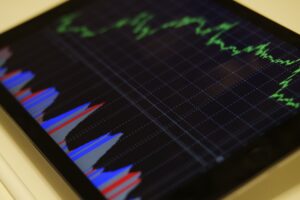Table of Contents
Predictive analytics for financial market trends
When it comes to crafting compelling content, two paramount factors come into play – “perplexity” and “burstiness.” Perplexity, in its essence, gauges the intricacy and intricateness of textual composition. Conversely, burstiness delves into the undulating cadence of sentences. As beings of cognition, humans tend to exhibit a fascinating array of linguistic diversity – a symphony of protracted, intricate sentences intermingled with crisp, succinct utterances .In stark contrast, artificial intelligence, abbreviated as AI, frequently abides by a structured and consistent framework. Consequently, as we embark on the forthcoming composition, it becomes paramount to imbue it with a thoughtful amalgamation of intricacy and diversity in sentence structure.
Illuminating the Financial Firmament
Venturing into the labyrinthine world of financial markets, we are invariably confronted with the multifaceted marvel that is predictive analytics. This technological juggernaut has orchestrated a seismic shift in how we fathom and forecast the enigmatic undulations of financial market trends. Within the confines of this discourse, we shall embark on an exhilarating journey, unearthing the profound significance and myriad applications of predictive analytics in unraveling the intricate tapestry of financial markets.
The Alchemical Elixir for Deciphering Stock Market Esoterica
In the realm of stock market dynamics, predictive analytics reigns supreme as the ultimate oracle, an instrument of transcendence that empowers investors and traders alike. Armed with the arsenal of historical data and real-time information, predictive analytics becomes an unfailing beacon, illuminating the treacherous terrain of stock market fluctuations. It bestows upon us the gift of foresight, enabling us to traverse the labyrinthine corridors of financial markets with unwavering precision.
The Renaissance of Financial Market Prognostication:
In the annals of financial market forecasting, we are amidst a profound renaissance, catalyzed by the advent of predictive analytics. The archaic methodologies of yesteryears have been relegated to the periphery, as they falter in delivering the precision and nuance demanded by the modern financial landscape. Predictive analytics, underpinned by a tapestry of historical narratives, statistical intricacies, and the finesse of machine learning algorithms, has emerged as the harbinger of precision in predicting the intricate choreography of market trends.
Long-Term Financial Trend Prediction Methods
Long-term financial trend prediction is crucial for investors with a strategic outlook. Predictive analytics employs sophisticated models to analyze historical data over extended periods, enabling investors to identify trends that may span years, thus making it invaluable for long-term investment planning.
Machine Learning in Financial Market Predictions
Machine learning is at the heart of predictive analytics for financial markets. These algorithms analyze extensive datasets to identify hidden patterns and make predictions with remarkable accuracy. By continuously learning from new data, machine learning models become increasingly adept at forecasting market trends.
Algorithmic Trading Strategies for Forecasting
Algorithmic trading, or algo-trading, relies heavily on predictive analytics. Traders use complex algorithms to execute orders automatically based on predefined criteria. These algorithms leverage real-time market data and predictive models to gain a competitive edge in the dynamic financial environment.
Illuminating Financial Market Trajectories

The bedrock of precise financial market trend analysis lies in the realm of predictive modeling. At its core, predictive modeling is a sophisticated mathematical endeavor, fashioning intricate models that cast their gaze into the future of market dynamics. These models, akin to chameleons, possess the remarkable ability to adapt to the ever-shifting tides of market conditions, rendering them indispensable tools for traders and investors navigating the labyrinth of finance.
Within the realm of predictive analytics, the central pursuit remains steadfast – the provision of pinpoint accuracy in trend analysis. Armed with the prowess to scrutinize vast reservoirs of data, this approach becomes the discerning eye that spots the most nuanced oscillations in market sentiment and investor conduct. It bestows upon traders and investors the precious gift of insight, enabling them to embark on their financial odyssey with prudence, thus mitigating the specter of potential monetary setbacks.
Data-Driven Predictions in Finance
Data-driven predictions have become integral to modern finance. Predictive analytics tools sift through extensive financial data, extracting valuable insights that inform investment strategies. These insights include identifying emerging market trends, detecting anomalies, and assessing risk levels.
Statistical Models for Financial Market Trends
Statistical models are instrumental in predictive analytics. They utilize mathematical techniques to analyze historical data and identify patterns. These models range from linear regression to more complex time series analysis, offering a diverse toolkit for market analysis.
Historical Data Analysis for Market Forecasting

Historical data analysis lies at the core of predictive analytics. By studying past market trends and events, analysts gain valuable insights into how the market behaves under different conditions. This historical context is invaluable for making predictions about future market movements.
Unveiling the Crystal Ball of Finance: Stock Price Prognostication with Analytics
At the heart of predictive analytics lies the pivotal endeavor of foreseeing stock prices, a venerated pursuit in the world of finance. Investors and traders, akin to modern-day oracles, place their trust in the intricate models meticulously crafted by this discipline. These models, akin to a finely tuned instrument, harmoniously consider an array of variables, including a company’s performance, the ever-fluctuating market sentiment, and the rhythmic cadence of economic indicators. In the crucible of computation, they distill these elements into a forecast that serves as a guiding star for crucial buying and selling decisions.
In the tempestuous seas of contemporary financial markets, the currency of information is real-time data. Predictive analytics tools act as vigilant sentinels, ceaselessly surveilling market conditions and delivering instantaneous updates and trend predictions. For traders, this real-time information is akin to the North Star, guiding their vessels through the tumultuous waters of finance, enabling them to seize fleeting opportunities with impeccable timing and precision.
Predictive Analytics for Cryptocurrency Markets
The cryptocurrency market’s volatility makes it an ideal candidate for predictive analytics. Machine learning algorithms analyze data from blockchain transactions, social media sentiment, and trading activity to predict cryptocurrency price movements.
AI-Driven Financial Market Predictions
Artificial intelligence (AI) is driving innovation in predictive analytics. AI-powered algorithms can analyze unstructured data, such as news articles and social media posts, to gauge market sentiment. This sentiment analysis provides insights into how external factors impact financial markets.
Sentiment Analysis in Financial Forecasting
Sentiment analysis, a subset of natural language processing, plays a vital role in financial forecasting. By analyzing news articles, social media posts, and other textual data, sentiment analysis tools assess the overall sentiment of market participants, aiding traders in anticipating market reactions to news events.
Predictive Analytics Tools for Traders
Traders have access to a wide range of predictive analytics tools and software. These tools offer customizable dashboards, real-time data feeds, and sophisticated analysis capabilities, empowering traders to make informed decisions.
Predictive Analytics Software for Finance
Institutional investors and financial institutions rely on predictive analytics software to manage portfolios and assess risk. These software solutions incorporate advanced algorithms and analytics to optimize investment strategies and reduce risk exposure.
Market Trend Prediction Algorithms
Market trend prediction algorithms are the backbone of predictive analytics. Designed to process vast amounts of data swiftly and accurately, these algorithms identify trends, patterns, and anomalies that may go unnoticed by human analysts.
Predictive Analytics in Investment Banking
Investment banks use predictive analytics to make informed investment decisions on behalf of their clients. Data-driven insights identify potential investment opportunities, assess risk, and optimize portfolio management.
Forecasting Economic Indicators with Analytics
Predictive analytics forecasts economic indicators, such as GDP growth, inflation rates, and unemployment figures. These forecasts are valuable for governments, businesses, and investors, providing insights into the overall economic landscape.
Big Data in Financial Market Predictions
The era of big data has transformed predictive analytics. With diverse data sources, including social media and online transactions, analysts access a wealth of information for predicting financial market trends.
Predictive Analytics for Portfolio Management
Portfolio managers use predictive analytics to build and manage investment portfolios. Analyzing historical data and market trends optimizes asset allocation, risk balance, and returns for clients.
Predictive Analytics in Risk Assessment
Risk assessment is vital in financial decision-making. Predictive analytics models evaluate risk associated with investments, aiding informed choices in line with risk tolerance.
Financial Market Trend Visualization
Data visualization tools are vital for conveying predictive analytics insights. These tools transform complex data into intuitive charts and graphs, enabling investors and traders to interpret information quickly and make data-driven decisions.
Predictive analytics for financial market trends is a transformative force in finance. It empowers investors, traders, and institutions to make data-driven decisions, optimize portfolios, and mitigate risks effectively. As technology advances, predictive analytics’ applications will expand, shaping finance’s future profoundly. Embrace the power of predictive analytics to gain a competitive edge in the dynamic world of financial markets.
May you Like: Overcoming the Complexities of Training Deep Neural Networks
Frequently Asked Questions (FAQs)
Q1: How does machine learning contribute to predictive analytics in finance?
A1: Machine learning algorithms play a crucial role in predictive analytics for financial markets. These algorithms can analyze vast datasets, identify patterns, and continuously improve predictions over time, making them invaluable in forecasting market trends.
Q2: Can predictive analytics be applied to cryptocurrency markets?
A2: Yes, predictive analytics is highly relevant to cryptocurrency markets due to their volatility. Machine learning algorithms analyze data from blockchain transactions, social media sentiment, and trading activity to predict cryptocurrency price movements.
Q3: What is sentiment analysis, and how does it aid in financial forecasting?
A3: Sentiment analysis involves analyzing textual data, such as news articles and social media posts, to gauge market sentiment. It helps in understanding how external factors impact financial markets and aids traders in anticipating market reactions to news events.
Q4: What is the role of predictive analytics in investment banking?
A4: Investment banks utilize predictive analytics to make informed investment decisions on behalf of their clients. It helps identify potential investment opportunities, assess risk, and optimize portfolio management.
Q5: How does predictive analytics contribute to risk assessment in finance?
A5: Predictive analytics models assess the risk associated with specific investments, enabling investors and institutions to make choices aligned with their risk tolerance. It aids in identifying and mitigating potential risks in financial decision-making.
Q6: How can data visualization tools enhance the understanding of predictive analytics insights?
A6: Data visualization tools transform complex data into intuitive charts and graphs, making it easier for investors and traders to interpret information quickly. These tools provide a visual representation of predictive analytics insights, aiding decision-making in financial markets.

